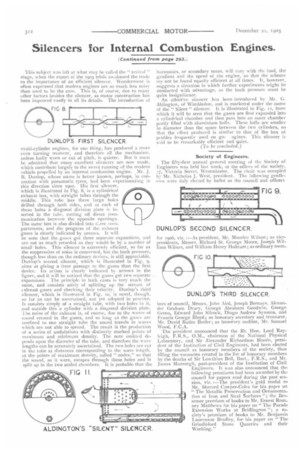Silencers for Internal Combustion Engines.
Page 14

If you've noticed an error in this article please click here to report it so we can fix it.
(Continued frorn page 293.) This subject was left at what !nay be called the " revival stage, when the report of the 1903 trials awakened the trade to the importance of an efficient silencer. Wonderment is often expressed that modern engines are so much less noisy than used to be the case. This is, of course, due to many other factors besides the silencer, as motor construction has been improved vastly in all ils details. The introduction of multi-cylinder engines, for one thing, has produced a more even turning moment, and therefore all the mechanism. unless badly worn or out of pitch, is quieter. But it must be admitted that many excellent silencers are now made, which contribute largely to the sweet running of the modern vehicle propelled by an internal combustion engine. Mr. J. B. Dunlop, whose name is better known, perhaps, in connection with pneumatic tyres, had been experimenting in this direction since two. His first silencer, which is illustrated in Fig. 8, is a cylindrical exhaust box, with straight tubes through the middle. This tube has three large holes drilled through both sides, and at each of these holes a diagonal division plate is inserted in the tube, cutting off direct communication between the opposite openings. The outer box is also divided into t:.ree compartments, and the progress of the exhaust gases is clearly indicated by arrows. It will be seen that the gases get three separate expansions, and are not as much retarded as they would be by a number of small holes. This silencer is extremely efficient, so far as the suppression of noise is concerned, but the back pressure, though less than on the ordinary devices, is still appreciable. Dunlop's second silencer, which is illustrated in Fig. 9, aims at giving a freer passage to the gases than the first device. Its action is clearly indicated by arrows in the figure, and it will be noticed that the gases get two separate expansions. The principle in both cases is very much the same, and consists solely of splitting up the stream of exhaust gases and checking their velocity. Dunlop's third silencer, which is illustrated in Fig. to, is novel, though, so far as can be ascertained, not yet adopted in practice. It consists simply of a straight tube, with two holes in it, and outside this a cylinder with a diagonal division plate. 1 he noise of the exhaust is, of course, due to the waves of sound created in the gases, and so long as the gases are confined to one straight tube the sound travels in waves which are not able to spread. The result is the production of a series of undulations with distinctly marked points of maximum and minimum density. The note emitted depends upon the diameter of the tube, and therefore the wave lengths can be accurately ascertained. The two holes are cut in ths tube at distances corresponding to the wave length, at the points of maximum density, called " nodes," so that the sound, as it were, escapes through these holes and is split up in the two sealed chambers. It is probable that the harmonics, or secondary notes, will vary with the load, the gradient and the speed of the engine, so that the scheme ow not be found equally efficient at all times. It, however, suggests a direction in which further experiments might be conducted with advantage, as the back pressure must be quite insignificant. An effective silencer has been introduced by Mr. G. Aldington, of Wimbledon, and is marketed under the name of the " Silent " silencer. It is illustrated in Fig. it, from which it will be seen that the gases are first expanded into a cylindrical chamber and then pass into an outer chamber partly filled with aluminium balls. These balls are smaller in diameter than the space between the two cylinders, so that the effect produced is similar to that of the box of pebbles frequently used on ga: agines. This silencer is said to be remarkably efficient and quiet. (To be concluded.) Society of Engineers.
The fifty-first annual general meeting of the Society of Engineers was held last week, at the offices of the society, 17, Victoria Street, Westminster. The chair was occupied by Mr. Nicholas J. West, president. The following gentlemen were duly elected by ballot as the council and officers for 1906, viz. :—As president, Mr. Maurice Wilson ; as vicepresidents, Messrs. Richard St. George Moore, Joseph William Wilson, and William Henry Holltum ; as ordinary mem hers of council, Messrs. John .lird, Joseph Bernays, Alexander Graham Drury, George Abraham Goodwin, George Green, Edward John Silcock, Diogo Andrew Symons, and Francis George Bloyd; as honorary secretary and treasurer, Mr. David Butler Butler; as honorary auditor, Mr. Samuel Wood, F.C.A.
The president announced that the Rt. Hon. Lord Rayleigh, F.R.S., 0.M., chairman of the National Physical Laboratory, and Sir Alexander Richardson Binnie, president of the Institution of Civil Engineers, had been elected by the council as honorary members of the society, thus filling the vacancies created in the list of honorary members by the deaths of Sir Lowthian Bell, Bart., F.R.S., and Mr. James Manserg-h, past-president of the institution of Civil Engineers. It was also announced that the following premiums had been awarded by the council for papers read during the past session, viz. :---The president's gold medal to Mr. Sherard Cowper-Coles for his paper on "The Metallic Preservation and Ornamentation of Iron and Steel Surfaces "; the Bessemer premium of books to Mr. Ernest Romney Matthews for his paper on "The Parade Extension Works at Bridlington "; a society's premium of books to Mr. Benjamin Laurenson Bradley, for his paper on "The Grindleford Stone Quarries and their Working."


















